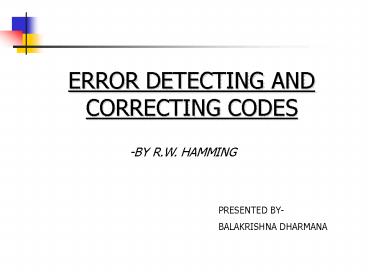ERROR DETECTING AND CORRECTING CODES PowerPoint PPT Presentation
1 / 19
Title: ERROR DETECTING AND CORRECTING CODES
1
ERROR DETECTING AND CORRECTING CODES -BY
R.W. HAMMING
PRESENTED BY- BALAKRISHNA DHARMANA
2
INTRODUCTION
- Why do we need error detection and correction?
- Unwanted Random signals interfere with accurate
transmission of signals - Some simple ways of error detection and
correction - Sending each word again
- Sending each letter again
- Within a computer errors are rare
3
- Systematic codes
- Redundancy
- R n/m
- Redundancy serves to measure the efficiency of
the code - Lowers the effective channel capacity
4
TYPES OF CODES
- Single error detecting codes
- Single error correcting codes
- Single error correcting plus double error
detecting codes
5
- Application of these codes may be expected to
occur under conditions- - Unattended operation over long periods of time
- Extremely large and tightly interrelated systems
where a single failure causes the entire
installation - When the signaling is not possible in the
presence of noise
6
SINGLE ERROR DETECTING CODES
- Contains n-bits
- Out of n-bits, n-1 are information bits and one
parity bit - Redundancy n/n-1
- As n increases probability of getting errors
increases - Type of check used to detect any single error is
called parity check (even or odd)
7
SINGLE ERROR CORRECTING CODES
- First assign m positions in available positions
as information positions - Specific positions are left to a later
determination - Assign k remaining positions as check positions
- Apply k parity checks
8
- The result of the k parity checks from right to
left is checking number - Checking number must describe mk1 different
things - so that, 2k gt m k 1
- writing n mk, we find
- 2m lt 2n / n1
9
(No Transcript)
10
- Now we have to determine the positions over which
the various parity checks are to be applied - Any position which has a 1 on the right of its
binary representation must cause the first check
fail. - By examining the binary form of the various
integers - 1 - 1
- 3 - 11
- 5 - 101
- 7 - 111 etc
11
TABLE II
12
(No Transcript)
13
SINGLE ERROR CORRECTING PLUS DOUBLE ERROR
DETECTING CODES
- Begin with single error correcting code
- Add one more position for checking all previous
positions using even parity check - In the operation of the code ,
- No errors all parity checks including the last
are satisfied - Single error- the last parity check fails
- Two errors- last parity check is satisfied and
indicates some kind of error
14
GEOMETRICAL MODEL
15
(No Transcript)
16
- At a given minimum distance, some of the
correctability can be exchanged for more
detectability. - For example, a subset with minimum distance 5 may
be used for - Double error correction
- Single error correction plus triple error
detection - Quadruple error detection
17
APPLICATION OF GEOMETRICAL MODEL TO CODES
- If code points are at a distance of at least 2
from each other then any single error will
carry the code point over to a point that is not
a code point. Means single error is detectable - If distance is at least 3 units then any single
error will leave the point nearer to the correct
code point than to any other code point, this
means single error will be correctable.
18
CONCLUSION
- This paper helps us to discuss the minimum
redundancy code techniques for - Single error detection
- Single error correction
- And single error correction plus double error
detection - Also gives the geometrical model of above
techniques in depth.
19
REFERENCE
- M. J. E. Golay, Correspondence, notes on Digital
coding, Proceedings of the I.R.E., Vol. 37, p.
657, June 1949. - http//www.math.ups.edu/bryans/current/journal_sp
ring_2002/300_EFejta_2002.htm - http//www.ee.unb.ca/tervo/ee4253/hamming.htm
- http//www.cs.mdx.ac.uk/staffpages/mattsmith/modul
es/COM1021/seminar_sheets

